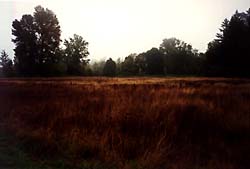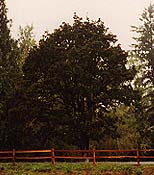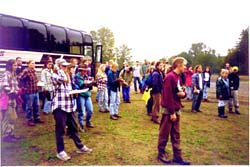|
Elijah Bristow State Park is on the flood plain of the coast fork of
the Willamette river. Forest and meadow continue their ancient competition
in
this area that while not pristine provides clues to what vegetation in the
Willamette river valley was like before the massive changes brought by
European conquest.
 Grasses
in fields rely on disturbance. Grasses have a competitive advantage over
trees in areas that experience frequent disturbance. Here this disturbance
might be the periodic flooding of the Willamette river. For thousands of
years disturbance in the Willamette valley came from human caused fire.
Now, it is a tractor that maintains many remaining Willamette valley
grasslands, including the field on the right.
 Oregon white oak, Quercus garryana, are prevalent in the
grassy areas around the river. Oaks and meadow extend up the hills --
especially the south-facing slopes or in areas with shallow soils. A few
of these oaks are older than 200 years and predate European settlement.
Oregon white oak, also known as Gary oak, is the predominate oak found in
the Willamette valley although some California black oaks are also around.
Oregon white oak is easy to identify by its characteristic oak leaves.
Like all white oaks the lobes on its leaves are rounded, while on the
black/red oaks the lobes are pointed. So in most of the valley its easy to
tell which oak you are looking at. An oak's generally round crown is one
way to recognize it from a distance.
Oregon white oak, Quercus garryana, are prevalent in the
grassy areas around the river. Oaks and meadow extend up the hills --
especially the south-facing slopes or in areas with shallow soils. A few
of these oaks are older than 200 years and predate European settlement.
Oregon white oak, also known as Gary oak, is the predominate oak found in
the Willamette valley although some California black oaks are also around.
Oregon white oak is easy to identify by its characteristic oak leaves.
Like all white oaks the lobes on its leaves are rounded, while on the
black/red oaks the lobes are pointed. So in most of the valley its easy to
tell which oak you are looking at. An oak's generally round crown is one
way to recognize it from a distance.
Oaks were an important part of the pre-European vegetation in the
Willamette valley both to other organisms and indigenous people. The
Calapooyans, who occupied this part of the Willamette valley, and
Native Americans in other areas periodically burned the oak grasslands for
a variety of reasons. A study in the Oregon white oak
woodlands of Humbolt Redwoods State Park,
California, revealed a history of fire every 7.5 to 13.3 years during the
pre-European era (cite).
Historically, Oregon white oak was subjected to a fire regime of
low-severity surface fires occurring every few years. Oregon white oak has
adapted to these low- to moderate-severity fires by sprouting from the
bole,
root crown, and roots; sprouts grow far more rapidly than do
seedlings; and young trees not subjected to periodic top-kill by fire
followed
by sprouting often do not attain sexual maturity before they succumb to
herbivores. Initial establishment of seedlings is somewhat dependent on fire
also.
 Almost all grasses in the Willamette valley are
non-native. In fact, this
is true of almost all grasslands in the US. European settlers and pathogens
greatly affected native people and North American ecosystems. Other
introduced organisms, ranging from rusts to rats, have also greatly altered
North American ecosystems. I have linked some information about non-native
species and the environmental history of the conquest of America below. I
would recommend Changes in the Land by William Cronon or any number
of other good books you can find on this interesting subject. Almost all grasses in the Willamette valley are
non-native. In fact, this
is true of almost all grasslands in the US. European settlers and pathogens
greatly affected native people and North American ecosystems. Other
introduced organisms, ranging from rusts to rats, have also greatly altered
North American ecosystems. I have linked some information about non-native
species and the environmental history of the conquest of America below. I
would recommend Changes in the Land by William Cronon or any number
of other good books you can find on this interesting subject.
White Alder Alnus rhombifolia, Western Red cedar Thuja
plicata, Incense cedar Calocedrus decurrens,
blackberries, along with Licorice fern and other epiphytic plants were
also seen in this area. The elevation here is 110 meters, mean annual temp
is
11.2 centimeters, and mean annual precipitation is 1040mm.
| 
